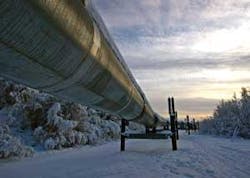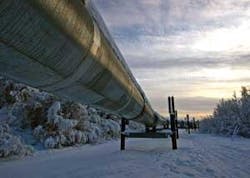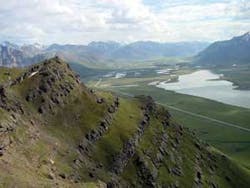Pitfalls abound in Alaskan effort to make gas pipeline a reality
In attempt to bring its vast reserves of North Slope natural gas to market, the State of Alaska has provided inducements that may not only assure the project’s failure, it may ultimately cost the state nearly $2.5 billion.
For many years it has been the dream of Alaskans to commercialize the vast reserves of North Slope natural gas as a way to extend the prosperity that oil brought to the state and its residents. Yet the commercial challenges are considerable.
The most attractive market for the gas appears to be linking up with the North America pipeline network. Cost estimates for such an endeavor vary between $30 billion and $40 billion in today’s dollars, and so in addition to the construction cost and gas market risks, there is a size risk; the cost of failure would be huge. Nevertheless, the project offers potentially much value for the producers.
Many Alaskans have been frustrated by the failure to commercialize. Indeed, many Alaskans also feel the project is feasible, and that the producers have not proceeded because they are either holding out for fiscal concessions from the state, or are developing projects elsewhere in places where their leases will lapse if they do not develop.
In addition, many Alaskans believe the oil development experience in Alaska was less than optimal due to producer ownership of the oil pipeline (the Trans-Alaska Pipeline [TAPS]), citing high tariffs filed by the producers that are deducted in deriving the tax and royalty basis of the oil. Moreover, despite federal law to the contrary, many Alaskans are concerned that a producer-owned gas pipeline would limit access to non-owners, thereby stifling new companies from exploring in Alaska.
These beliefs were embraced by key resource development officials that came into power with the Palin administration in 2006.
It is against this background that the Alaska Gasline Inducement Act (AS 43.90 – AGIA) was drafted and submitted by the administration to the legislature, and passed in the early days of the administration. The administration’s argument was that rather than relying solely on the producers, competition among companies for certain state inducements to build the line would move the project forward. Moreover, AGIA, its supporters say, ameliorates some of the concerns of a producer-dominated line.
AGIA overview
AGIA operates as follows:
The state awards an exclusive AGIA licensee to a qualified applicant with a qualified application.
In exchange for certain performance requirements the state will reimburse a share of the licensee’s costs of a) getting to open season, and b) trying to get a FERC certificate of public convenience and necessity (“certificate”) for the pipeline. In particular, the state will reimburse the licensee up to 50% of the costs of getting to the first open season, and up to 90% thereafter of the costs of getting to certification, up to a maximum of $500 million. The specific percentages and maximum dollar reimbursement are identified as part of the application.
The performance requirements include:
- Conclude a binding open season within 36 months of the license award;
- Apply for a FERC certificate by a certain date as established in the application;
- Advocate rolled-in rates for pipeline expansion capacity, not to exceed 15% above the base shipping rate;
- Sanction the project by a date certain depending on whether the licensee has credit support to finance construction;
- In addition, there are requirements for periodic assessment of market demand, capacity expansion when warranted, capital structure limits on equity, providing for in-state gas, and local hire during construction.
There are upstream resource inducements to any shipper that signs on to the project, and exclusivity assurances for the licensee, both discussed below.
AGIA called for the state to award the license among competing applications based on a combination of the net present value of the application to the state coupled with an assessment of its probability of success. AGIA passed the legislature in May 2007.
In August 2008 the state awarded the license to the TransCanada Corp. after receipt of five applications, four of which did not meet all the stipulated terms. Per TransCanada’s application the state will reimburse them at the maximum AGIA dollar amount of $500 million and maximum reimbursement rates of 50% before open season and 90% after.
Preamble: Overstating the economics
In presentations to the state legislature in support of AGIA, the administration derived the following internal rates of return (IRR) for the producers from a producer-owned vs. third-party independent pipeline. The producer-owned returns were predicated on straight cash outlays for the project. The third-party pipeline returns were predicated on cash flows underscored by the tariff payments. (See Table below)
The third-party pipeline had a higher rate of return at a $3.50/mmbtu price than the producer-owned pipeline had at an $8.50/mmbtu price. These were presented as a straight “apples-to-apples” comparison.
Third-party pipelines are financed by long-term shipping commitments. These commitments are liabilities. The tariff payments represent repayment of debt. Debt, or leverage, will most always increase the rate of return. However, whereas unleveraged the hurdle rate is the weighted average cost of capital, with debt the hurdle rate is the higher cost of equity.
Therefore, leveraged cash flows cannot be simply compared with unleveraged cash flows because they have different hurdle rates.
A third-party pipeline represents 100% leverage to the producers. With full leverage there are no up-front payments. Because there is no capital for there to be a return on, the IRR will be infinity. (The reason the rates were not infinity under the administration’s analysis is because the modeling included some upstream development costs as well as the downstream pipeline.) However, so is the hurdle rate.
The hurdle rate is also the discount rate for NPV analysis. The administration similarly overstated the NPV’s for third-party pipelines by using the WACC rather than the cost of equity for the discount rate.
There is an old adage in finance that you cannot make a bad project good by borrowing money. AGIA was in part a reaction to the administration’s belief that the increased rate of return made the project unquestionably economic, and why they championed a third-party pipeline. It may also explain why they may have understated what are serious commercial defects in AGIA.
Commercial problems
There are two major steps prior to constructing any gas pipeline. First, there is an open season, where firm contractual commitments are made by gas producers to pay to ship the gas over a long time period. These commitments allow the pipeline to get financing. Second, the pipeline owner needs to obtain a FERC certificate.
Without the commitments of the producers to ship their gas, the Alaska pipeline cannot get financing and will not be built.
But there are some very significant commercial problems with AGIA that make it unlikely producers will commit gas and unlikely that AGIA will ever lead to a pipeline. The most significant ones include:
a) Inadequate preparation for the open season
The open season documents contain an estimate of what the tariff is going to be. Before an open season, a significant amount of front-end engineering needs to occur so that subscribers are sufficiently confident in the estimate so that they are comfortable in making the commitment to sign a contract to use the pipeline.
The relationship between spending and cost accuracy is very pronounced. It is generally recognized that for a project of this magnitude there should be a considerable amount of spending to get to a sufficient open season, upwards of 2% of total installed cost. TransCanada’s 2008 construction cost estimate was $26 billion to Alberta. Two-percent would equate to $520 million.
Yet TransCanada is only going to spend $83 million to get to an open season. Why? Because under AGIA the state will reimburse TransCanada for 50% of the costs before open season and 90% of the costs after. The AGIA structure motivates the licensee to do a scant job of engineering, back-end loading its costs to the 90% reimbursement period. Thus the cost estimate for open season will be inadequate, which will likely result in no significant commitments.
b) Rolled-in rates
Under AGIA, if expansion capacity in the pipeline has a higher tariff than the base capacity, the licensee must advocate rolled-in tariff rate treatment before FERC, where the costs of the base and expansion capacity are combined and averaged in a single tariff, not to exceed 15% above the base shipping rate.
Ordinarily under FERC rules in this situation the shippers on the additional capacity pay the difference. Otherwise, the base shippers are subsidizing the expansion shippers.
The administration’s intent is that this would help encourage exploration by having the base shippers help pay for new capacity.
TransCanada’s levelized tariff estimate for the Alaska portion of the pipeline is $1.03/mmbtu to Alberta. Thus the rolled-in rates could increase tariffs to base shippers by 15 cents/mmbtu.
The producers, or any initial shipper, will most likely never agree to this as an unfair and unreasonable subsidy of the expansion shippers at their expense.
Of course this is the reason why a pipeline company like TransCanada, and not a producer, could easily abide by the AGIA terms. They won’t be subsidizing the expansion shippers; the producers will. TransCanada would be spending other peoples’ money. However, even if it were desirable to have the producers subsidize explorers, there are some very important reasons why rolled-in rates should give the state pause.
First, rolled-in rates will encourage explorers to postpone exploration, so as not to commit gas at the first open season. Because their expansion capacity could be subsidized, they can afford to sit back and wait and see whether the pipeline has cost overruns, and how gas markets look down the road. If the pipeline turns out to be expensive, or gas markets falter, they can simply explore elsewhere in the world and avoid the project. But if things turn out well, they can explore and commit later knowing they won’t be penalized for waiting.
The rolled-in rates create a value to delaying commitment. In essence, the producers will be absorbing the explorers’ exploration risk, with the result being deferred exploration and possibly a smaller base pipeline with higher tariffs, which reduces the value of the project.
c) Alberta Hub
Under TransCanada’s AGIA application the pipeline will bring Alaska gas into the Alberta Hub. The Hub is a series of pipelines within Alberta that transfer gas from one part of Alberta to another, where it can go on into existing pipelines to other North American markets.
TransCanada owns the Hub. It costs about 24 cents/mmbtu for shippers to put gas into the Hub. TransCanada will make lots of money off this. TransCanada also owns the pipes going out of the Hub, where it would also make money.
Bringing gas into the Hub may make sense if there is existing capacity in the pipelines exiting from the Hub and those pipelines go to the desired market. Gas production from Western Canada has been declining over the past few years, which may free up capacity in existing pipelines.
However, there are reasons it may not make sense to go into the Hub, particularly if there is insufficient capacity in these existing pipes. Rising gas prices have caused unconventional gas production (shale gas, coalbed methane) to explode in recent years. The gas shale potential of Western Canada is enormous. This shale gas could absorb all the existing pipeline capacity out of Canada.
If all or most of the gas is going to the Upper Midwest, and it makes sense to bypass the Hub completely because there is not sufficient existing pipeline capacity out of Alberta to the desired market, there may be a need for a new dedicated line to Chicago, or use of existing capacity not owned by TransCanada, such as the Alliance Pipeline. But if it makes sense for the gas to bypass the Hub, it cannot be done under AGIA.
This is another perverse effect of the AGIA structure. What AGIA has set up is a structure where the pipeline company is determining the market.
d) Misalignment of interests
The producers ultimately pay the cost of the pipeline through the tariff. Thus they have a greater incentive to contain costs. Shippers lose money on cost overruns; carriers make money. That is why they want to build it.
e) Weak upstream inducements
AGIA provides upstream resource inducements. For a producer that commits gas at the first open season, the production tax inducement freezes for 10 years the tax structure for natural gas as it exists at the time of the open season.
However, if the legislature decides to change taxes within that 10-year period it could do so through a two-step process: amend AGIA and change taxes. This should hardly provide any comfort to the taxpayers regarding tax stability.
f) FERC certification in the absence of commitments
AGIA requires TransCanada to try to get a FERC certificate even if the open season fails. That mainly involves the environmental impact statement (EIS), permitting, and detailed engineering. TransCanada plans to spend $542 million beyond the open season to try to get the certificate, of which the state will pay 90%.
Yet FERC has never granted a certificate for a natural gas pipeline in the absence of firm shipping commitments. It would make no sense for them to do so, and FERC officials have said that they do not know how they could do it. It is the FT commitments themselves that demonstrate the public need underlying the certificate.
Financial risk to the state: triple damages
The financial exposure to the state could be much more than the $500 million. Section AS 43.90.440 of AGIA, the “license project assurances,” otherwise known as the “triple damages clause,” states that if the state extends preferential royalty or tax treatment to facilitate the construction of a competing project, the licensee is entitled to three times the expenditures it incurred.
In April 2008 BP and ConocoPhillips formed the Alaska Gas Pipeline LLC (the “Denali project”) to pursue development of the project. It is proceeding completely outside the AGIA process. But it should not be assumed both AGIA and the producers efforts can proceed simultaneously, and the state can just out. The AGIA process could very well create a material interference with the producer project.
If the state believes it is necessary to enact fiscal modifications to enhance the producer project, either a) the state may be unable to do so because of the large financial penalty it would incur from the damage claim by TransCanada under AGIA, or b) the state would incur the financial penalty itself for doing so.
And some very serious problems have been identified with the current production tax as it would apply to gas. These include:
- The progressivity structure in tax could cause a significant reduction in oil taxes with the introduction gas production;
- Very high marginal tax rates at high prices eliminate much of the upside potential of the project; and
- The producers have long advocated that some long-term fiscal stability package will be necessary for a project of this magnitude to proceed.
The language of the clause clearly determines that the triple damages are based on gross expenditures. So if TransCanada spends $625 million to try to get a FERC certificate (per their application), and then the state makes a fiscal adjustment to help another project, invoking the triple damages, the state would owe the company $1.875 billion, plus the $500 million the state had already paid.
Conclusion
All AGIA offers is $500 million (6 cents/mmbtu). The additional commercial challenges it creates suggest it will not work.
Many of the Alaskans behind AGIA have long maintained that the state leases compel the producers to develop a gas pipeline. And perhaps we can guess that these Alaskans see AGIA, and the eventual producer non-response to it, as a way to create evidence in some future “duty-to-perform” challenge to the companies’ right to retain the leases. Surely the commercial failures of AGIA will be defense enough against that.
If only the failure of AGIA itself were the end of it, the loss of $500 million to the public treasury might only be deemed a “considerable” calamity. The ultimate public policy failure will not be the failure of AGIA. It will be the triple damages: the “poison pill” that endures. AGIA leaves the state no room for risk if it does not work. It is not unimaginable that this is what motivated TransCanada to participate: laying out $125 million for the chance to recoup $1.875 billion.
So the scenarios are either TransCanada cashes in on that bet, or the state is powerless to fiscally accommodate another project, degrading the landscape for getting any gas pipeline. Either way, there is a dreadful cost to the public.
About the author
Roger Marks is a petroleum economist based in Anchorage, Alaska. He focuses on tax, regulatory, and resource issues. He also writes on oil and gas issues and teaches economics locally.





